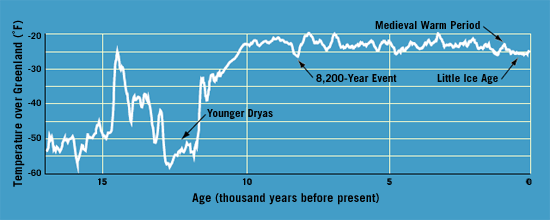
Introduction
Measurements of climate using modern instruments have produced a record of the last 150 years or so. In order to reconstruct changes in the climate system further back in time than 150 years, scientists use natural archives of climatic and environmental changes, such as ice cores, tree rings, ocean and lake sediments, corals, and historical evidence. Scientists call these records "proxies" because, although the proxies are not usually direct measures of temperature or other climatic variables, they are affected by temperature. Therefore, the changes in the proxies preserved in the historical record can give us an idea of what the climate was in the distant past.
Climate Story
Climate has profoundly impacted and shaped the lives of humans over their entire existence. In turn, we humans, via our activities, have impacted local and regional climate and also now even perhaps the global climate. Beginning around 10,000 years ago, the Agricultural Revolution (which led to more abundant and easier obtained sources for food) and resultant growth in population altered the local and regional climate of many regions around the world including islands. For example, as huge tracks of forest were felled to make way for agriculture (in this example to grow crops) to support growing populations, the pre-Agricultural Revolution Mediterranean hydrological cycle and thus climate was altered from a wet to the present relatively dry climate.
In the past half-century, we humans have increased our monitoring of various aspects or indicators of climate change to understand further how climate not only changes, but also to predict what impact these changes might have on the world around us. One area of monitoring focus has been on greenhouse gases. Atmospheric levels of gases, such as carbon dioxide (CO2), methane (CH4), nitrous oxide (N2O), chlorofluorocarbons (CFCs), and sulfate (SO4) aerosols have all been sampled and concentrations recorded for the past half-century or longer. The measured increases in atmospheric concentrations of these gases and aerosols along with historical comparisons from proxy records have led the world’s community – on local, regional, national, and international levels – to consider the potential climatic implications of past, current, and future increases in greenhouse gases.
There are many records of the Earth's past climate. The one below depicts the air temperature above Greenland for the past 20,000 years. Temperature is on the y-axis and years before present on the x-axis. The graph shows the last major glaciation of the "Younger Dryas" about 12,500 years ago (notice the large drop in temperature) followed by the subsequent relative warm period for the past 10,000 years. The "Little Ice Age", occuring around from 1550 to 1850 is a small deviation to colder temperature in an otherwise relatively warm era of the past 10,000 years. What have we humans done over the past 100 to 200 years to perturb this our Earth's climate system?
